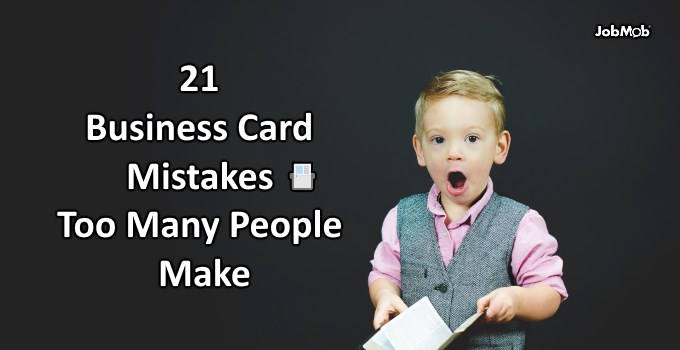Luckily, it's not hard to avoid these blunders.
This is a guest post by Bill Post.
How can you make sure that your business card is the most effective tool that it can be? By avoiding these errors.
Note: There is a poll embedded within this post, please visit the site to participate in this post's poll.Business card blunders you don't want to make
1) Vague personal branding
Someone reading your card should immediately be able to tell what kind of work you do.
2) Unsuitable business card style
If you are in a conservative industry, such as law or finance, you'll want a simple white business card with black ink, raised lettering, and very little, if any, color. If you are a graphic designer, though, you may want something more creative.
3) Personal logo abuse
If you have a personal logo on your resume, it should be on your business cards – everything should match.
However, don't make the logo over-sized. Keep it understated, so that you have room for your contact information and don't need to print your phone number and address in print so tiny that your contact with need a magnifying glass to read it.
4) Putting a photo of yourself on your business card
Unless you are an actor or are trying to get a job as a network news anchor, or are in some other business where your face is part of what you are trying to sell. Otherwise, the photo just makes the card look schmaltzy.
5) Gimmicks
Don't add a gimmick to your card without a good reason.
These days, everyone wants to stand out by producing a business card that is different and unique (like one that uses augmented reality). But when it comes to business cards, unless you have a special, business-related reason for making your business card different (i.e., you are a professional magician and your business card is embedded with a hologram), a traditional card is best.
Why?
Ultimately a business card is a tool – it's meant to provide information that you hope will end up in someone's rolodex (or the equivalent).
Don't let your desire to make your card different pull you away from the purpose of a business card.
6) Non-traditional sizes or formats
I've heard of people handing out chocolate business cards.
Kudos for creativity, but do you think a chocolate card is going in the rolodex? My guess is that it will become a mid-afternoon snack!
Cards in various non-traditional sizes are also unlikely to make it into a rolodex – they just don't fit. Do you want to force your new contact to copy your information onto a rolodex card?
The one exception to this rule is the folding business card, which is the traditional size when it is folded.
7) Leaving off important contact information
I realize that privacy is important, but make sure that your business card contains all the potential ways that a contact might want to try to reach you.
Don't limit your contact information to an address and phone number. Include your email address, your IM/Skype handle, your website, and any social media contact information (such as Twitter and Facebook usernames) that a contact might want to use to reach or find out more about you.
8) Making important contact information too hard to read
Use a readable font that is printed in as large a size as you can reasonably fit on the card.
Don't make your visual elements so large that you don't have room to add legible text.
9) Making important contact information too hard to find
Your contact may never look at the back of your card – if you must put something there, make it your personal logo, an inspirational quotation, a testimonial or two, or something else appropriate to your profession or industry.
For example, if you are a chef, you might be able to put a very simple menu or recipe on the back of a card.
10) Handwriting changes of contact information on old cards
Make sure you have new ones with the new information clearly noted. Otherwise, you create the impression that you are someone who tends to procrastinate – even about updating your own business cards!
11) Forgetting your business cards at home
If you are not used to carrying a business card, this may be the biggest obstacle you have to overcome.
Get yourself a nice business card case to hold your cards and put it next to your wallet and keys, or in your briefcase or bag, so that you won't forget to bring your cards along to your next networking event, job fair or professional conference.
12) Keeping business cards in your wallet
Cards in a wallet tend to get rumpled and smudged, and there is always the chance that you'll drop the contents of your wallet all over the floor while struggling to extricate a business card that got wedged behind your driver's license. That won't make a smooth impression.
13) Choosing the wrong situation to give out a card
Be sensitive about when you choose to give out your business card.
Of course, do give your card to anyone who asks for it, to anyone who requests your contact information, or to anyone who asks for information about your profession or industry.
Equally obviously, don't give out your card at funerals or weddings, meetings with your child's teachers (unless you are specifically asked e.g. by a teacher who wants you to be a volunteer speaker for the class), at doctor's appointments, or in any other potentially uncomfortable situation.
You must also be sensitive to the kind of interest that is expressed in social situations – someone who asks you at a party what you do is better responded to conversationally, not by digging out your business card.
In fact, as a general rule, don't give out your business card in personal social situations unless you are asked for it, but do feel free to give out your card at professional conferences and networking events.
14) Choosing the wrong time to give out a card
Don't give your card at the beginning of a meeting or event. This is one of those subtle things, but it is important. It gives the impression of arrogance if you toss a card at someone you've just met.
If you at least wait to exchange cards until you've spent some time together, it will feel more natural, as if you're giving a new friend a way to reach you rather than trying to make a sales pitch (and while we are on the subject – never, ever, make a sales pitch while handing someone your business card).
Handing out business cards is a delicate situation – one that requires a good grasp of the finer points of business etiquette. If you feel totally at sea, don't hesitate to take a class or read a good book on business etiquette to help you to get a feel for it. It's well worth your time to do so.
15) Being culturally insensitive with your cards
In some cultures, it matters what hand you use to give out business cards – always use your right hand, if you are using just one hand. However, in Asian cultures, it is polite to use both hands to present your business card.
If you are meeting potential employers or contacts in an international context, look up the guidelines for presenting and receiving business cards in the country where you will be.
If you will be spending time in a country where the dominant language is not your own, have your business cards printed double-sided, with one language on one side and one on the other.
16) Giving out cards wildly
It is important to not paper the community with your business cards. You are better off handing out cards to a few quality contacts who really plan to get in touch with you again, than giving them out willy-nilly to many people you have just met, who may have no real interest in contacting you again in the future.
17) Being stingy with your cards
Yet- if you are in a group of people, and are offering your business card to one person, offer it to the entire group. Otherwise, the other people in the group may feel deliberately excluded.
18) Not handing out your cards at all
Amazingly enough, many people order business cards, and end up with a professional, beautifully printed card that they keep in their briefcase or on a shelf. What a waste of money – and of a potential marketing tool! No business card is going to end up in a contact's rolodex if you don't hand that card out at every opportunity.
19) Forgetting to get the card from the person to whom you just gave yours
If you don't ask for a card from someone who has just asked for yours, you give the impression that you are not as interested in this person as he or she is in you.
20) Writing on the business card that was just handed to you
It will seem as though you are defacing their card. Treat all business cards, including your own, as though they are pieces of gold.
If you face a situation where the only paper on which to write is a contact's card or your own, write on the back of one of your own cards.
21) Giving out business cards with wrong information
Nailed it:
Bonus tip!
Give close friends and colleagues several of your business cards, which they can then use to refer people to you.
About the author
Bill Post, Small Business Research Analyst, has been providing research on issues of concern to small businesses for 123Print.com Business Card Design for three years. A former business owner prior to his involvement with 123Print Custom Business Cards, Bill spent several years after receiving his degree in the fast-paced corporate world before going out on his own to provide marketing and branding services to other small businesses in the Washington, DC metro area.
READ NEXT: 37 Ideas to Grow Your Job Search Network Right Now
Subscribe to JobMob via RSS or email and follow me on Twitter for the best job search tool insight.
from JobMob https://ift.tt/2GVHdAS




Aucun commentaire:
Enregistrer un commentaire